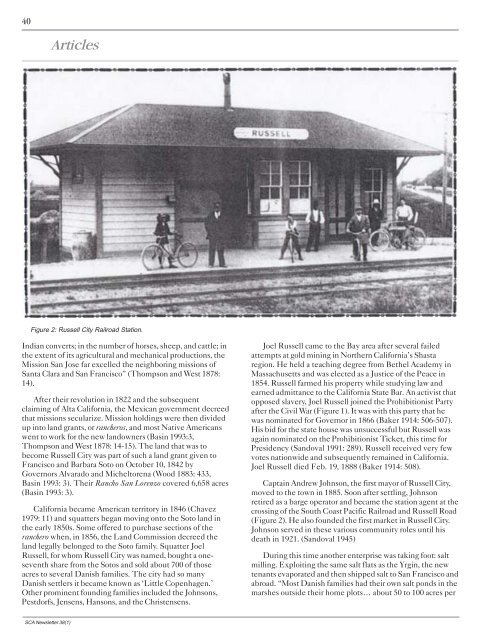March 2004 - Society for California Archaeology
March 2004 - Society for California Archaeology
March 2004 - Society for California Archaeology
You also want an ePaper? Increase the reach of your titles
YUMPU automatically turns print PDFs into web optimized ePapers that Google loves.
40<br />
Articles<br />
Figure 2: Russell City Railroad Station.<br />
Indian converts; in the number of horses, sheep, and cattle; in<br />
the extent of its agricultural and mechanical productions, the<br />
Mission San Jose far excelled the neighboring missions of<br />
Santa Clara and San Francisco” (Thompson and West 1878:<br />
14).<br />
After their revolution in 1822 and the subsequent<br />
claiming of Alta Cali<strong>for</strong>nia, the Mexican government decreed<br />
that missions secularize. Mission holdings were then divided<br />
up into land grants, or rancheros, and most Native Americans<br />
went to work <strong>for</strong> the new landowners (Basin 1993:3,<br />
Thompson and West 1878: 14-15). The land that was to<br />
become Russell City was part of such a land grant given to<br />
Francisco and Barbara Soto on October 10, 1842 by<br />
Governors Alvarado and Micheltorena (Wood 1883: 433,<br />
Basin 1993: 3). Their Rancho San Lorenzo covered 6,658 acres<br />
(Basin 1993: 3).<br />
Cali<strong>for</strong>nia became American territory in 1846 (Chavez<br />
1979: 11) and squatters began moving onto the Soto land in<br />
the early 1850s. Some offered to purchase sections of the<br />
ranchero when, in 1856, the Land Commission decreed the<br />
land legally belonged to the Soto family. Squatter Joel<br />
Russell, <strong>for</strong> whom Russell City was named, bought a oneseventh<br />
share from the Sotos and sold about 700 of those<br />
acres to several Danish families. The city had so many<br />
Danish settlers it became known as ‘Little Copenhagen.’<br />
Other prominent founding families included the Johnsons,<br />
Pestdorfs, Jensens, Hansons, and the Christensens.<br />
Joel Russell came to the Bay area after several failed<br />
attempts at gold mining in Northern Cali<strong>for</strong>nia’s Shasta<br />
region. He held a teaching degree from Bethel Academy in<br />
Massachusetts and was elected as a Justice of the Peace in<br />
1854. Russell farmed his property while studying law and<br />
earned admittance to the Cali<strong>for</strong>nia State Bar. An activist that<br />
opposed slavery, Joel Russell joined the Prohibitionist Party<br />
after the Civil War (Figure 1). It was with this party that he<br />
was nominated <strong>for</strong> Governor in 1866 (Baker 1914: 506-507).<br />
His bid <strong>for</strong> the state house was unsuccessful but Russell was<br />
again nominated on the Prohibitionist Ticket, this time <strong>for</strong><br />
Presidency (Sandoval 1991: 289). Russell received very few<br />
votes nationwide and subsequently remained in Cali<strong>for</strong>nia.<br />
Joel Russell died Feb. 19, 1888 (Baker 1914: 508).<br />
Captain Andrew Johnson, the first mayor of Russell City,<br />
moved to the town in 1885. Soon after settling, Johnson<br />
retired as a barge operator and became the station agent at the<br />
crossing of the South Coast Pacific Railroad and Russell Road<br />
(Figure 2). He also founded the first market in Russell City.<br />
Johnson served in these various community roles until his<br />
death in 1921. (Sandoval 1945)<br />
During this time another enterprise was taking foot: salt<br />
milling. Exploiting the same salt flats as the Yrgin, the new<br />
tenants evaporated and then shipped salt to San Francisco and<br />
abroad. “Most Danish families had their own salt ponds in the<br />
marshes outside their home plots… about 50 to 100 acres per<br />
SCA Newsletter 38(1)

















